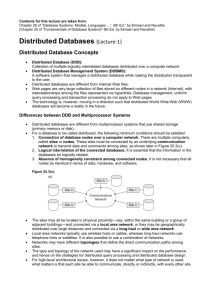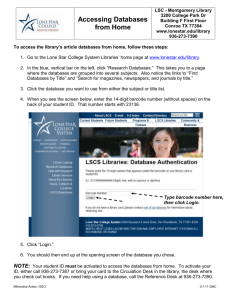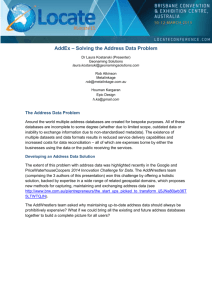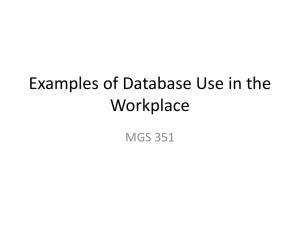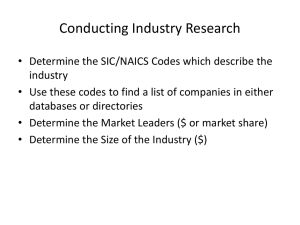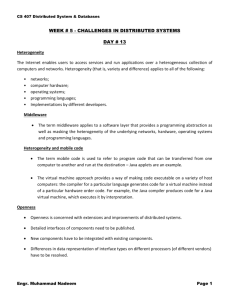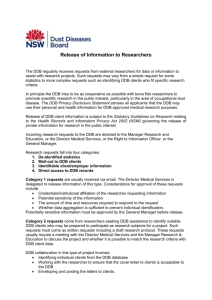Distributed Databases: Concepts, Advantages, and Types
advertisement
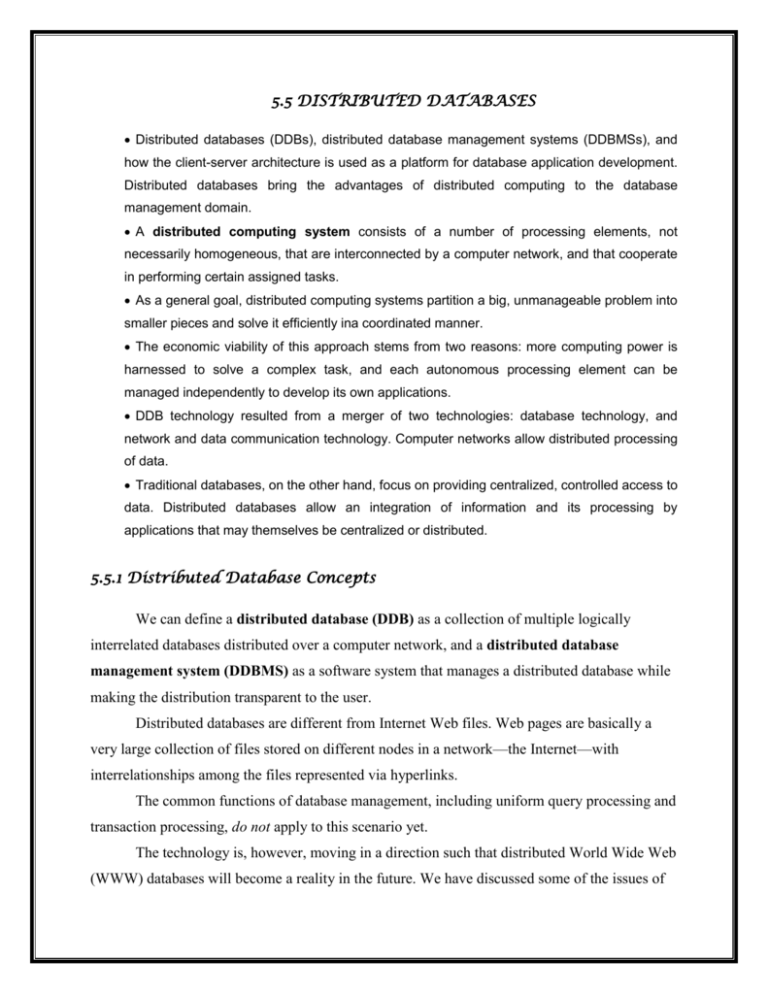
5.5 DISTRIBUTED DATABASES Distributed databases (DDBs), distributed database management systems (DDBMSs), and how the client-server architecture is used as a platform for database application development. Distributed databases bring the advantages of distributed computing to the database management domain. A distributed computing system consists of a number of processing elements, not necessarily homogeneous, that are interconnected by a computer network, and that cooperate in performing certain assigned tasks. As a general goal, distributed computing systems partition a big, unmanageable problem into smaller pieces and solve it efficiently ina coordinated manner. The economic viability of this approach stems from two reasons: more computing power is harnessed to solve a complex task, and each autonomous processing element can be managed independently to develop its own applications. DDB technology resulted from a merger of two technologies: database technology, and network and data communication technology. Computer networks allow distributed processing of data. Traditional databases, on the other hand, focus on providing centralized, controlled access to data. Distributed databases allow an integration of information and its processing by applications that may themselves be centralized or distributed. 5.5.1 Distributed Database Concepts We can define a distributed database (DDB) as a collection of multiple logically interrelated databases distributed over a computer network, and a distributed database management system (DDBMS) as a software system that manages a distributed database while making the distribution transparent to the user. Distributed databases are different from Internet Web files. Web pages are basically a very large collection of files stored on different nodes in a network—the Internet—with interrelationships among the files represented via hyperlinks. The common functions of database management, including uniform query processing and transaction processing, do not apply to this scenario yet. The technology is, however, moving in a direction such that distributed World Wide Web (WWW) databases will become a reality in the future. We have discussed some of the issues of 5.5.2 Differences between DDB and Multiprocessor Systems We need to distinguish distributed databases from multiprocessor systems that use shared storage (primary memory or disk). For a database to be called distributed, the following minimum conditions should be satisfied: ■ Connection of database nodes over a computer network. There are multiple computers, called sites or nodes. These sites must be connected by an underlying communication network to transmit data and commands among sites. ■ Logical interrelation of the connected databases. It is essential that the information in the databases be logically related. ■ Absence of homogeneity constraint among connected nodes. It is not necessarythat all nodes be identical in terms of data, hardware, and software. 5.5.3 Transparency The concept of transparency extends the general idea of hiding implementation details from end users. A highly transparent system offers a lot of flexibility to the end user/application developer since it requires little or no awareness of underlying details on their part. In the case of a traditional centralized database, transparency simply pertains to logical and physical data independence for application developers. However, in a DDB scenario, the data and software are distributed over multiple sites connected by a computer network, so additional types of transparencies are introduced. ■ Data organization transparency (also known as distribution or networktransparency). This refers to freedom for the user from the operational details of the network and the placement of the data in the distributed system. It may be divided into location transparency and naming transparency. Location transparency refers to the fact that the command used to perform a task is independent of the location of the data and the location of the node where the command was issued. Naming transparency implies that once a name is associated with an object, the named objects can be accessed unambiguously without additional specification as to where the data is located. Replication transparency. As we show in Figure 25.1, copies of the same data objects may be stored at multiple sites for better availability, performance, and reliability. Replication transparency makes the user unaware of the existence of these copies. Fragmentation transparency. Two types of fragmentation are possible. Horizontal fragmentation distributes a relation (table) into sub relations 5.5.4 Autonomy o Autonomy determines the extent to which individual nodes or DBs in a connected DDB can operate independently. o A high degree of autonomy is desirable for increased flexibility and customized maintenance of an individual node. Autonomy can be applied to design, communication, and execution. o Design autonomy refersto independence of data model usage and transaction management techniques among nodes. o Communication autonomy determines the extent to which each node can decide on sharing of information with other nodes. o Execution autonomy refers to independence of users to act as they please. 5.5.5 Reliability and Availability o Reliability and availability are two of the most common potential advantages cited for distributed databases. o Reliability is broadly defined as the probability that a system is running (not down) at a certain time point, whereas availability is the probability that the system is continuously available during a time interval. We can directly relate reliability and availability of the database to the faults, errors, and failures associated with it. o A failure can be described as a deviation of a system’s behavior from that which is specified in order to ensure correct execution of operations. o Errors constitute that subset of system states that causes the failure. Fault is the cause of an error. 5.5.6 Advantages of Distributed Databases Organizations resort to distributed database management for various reasons. Some important advantages are listed 1. Improved ease and flexibility of application development. 2. Increased reliability and availability. 3. Improved performance. 4. Easier expansion. 5.5.7 Additional Functions of Distributed Databases ■ Keeping track of data distribution. The ability to keep track of the data distribution, fragmentation, and replication by expanding the DDBMS catalog. ■ Distributed query processing. The ability to access remote sites and transmit queries and data among the various sites via a communication network. ■ Distributed transaction management. The ability to devise execution strategies for queries and transactions that access data from more than one site and to synchronize the access to distributed data and maintain the integrity of the overall database. ■ Replicated data management. The ability to decide which copy of a replicated data item to access and to maintain the consistency of copies of a replicated data item. ■ Distributed database recovery. The ability to recover from individual site crashes and from new types of failures, such as the failure of communication links. ■ Security. Distributed transactions must be executed with the proper management of the security of the data and the authorization/access privileges of users. ■ Distributed directory (catalog) management. A directory contains information (metadata) about data in the database. The directory may be global for the entire DDB, or local for each site. The placement and distribution of the directory are design and policy issues 5.5.8 Types of Distributed Database Systems The term distributed database management system can describe various systems that differ from one another in many respects. The main thing that all such systems have in common is the fact that data and software are distributed over multiple sites connected by some form of communication network. In this section we discuss a number of types of DDBMSs and the criteria and factors that make some of these systems different.
